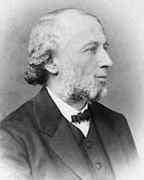Person: Borchardt, Carl Wilhelm

Carl Borchardt was a German mathematician who worked in a variety of areas in analysis. He edited Crelle's Journal for more than 30 years.
Mathematical Profile (Excerpt):
- Certainly Borchardt was impressed with Franz Neumann and, much later, he was one of three mathematicians who proposed Franz Neumann for external membership of the Berlin Academy in 1853.
- Borchardt's doctoral work, on non-linear differential equations, was supervised by Jacobi and submitted in 1843.
- He went with Borchardt and they spent time in both Rome and Naples.
- Dirichlet and Steiner were also in Rome at the same time and it proved a useful time for Borchardt.
- He attended a course by Liouville on doubly periodic functions and although Liouville intended to publish the notes which Borchardt took of his lectures, in the end they were not published due to a priority dispute between Liouville and Hermite.
- Borchardt taught at the University of Berlin from 1848 when he was appointed as a Privatdozent.
- The correct title of the Journal was the Journal für die Reine und Angewandte Mathematik Ⓣ(Journal of Pure and Applied Mathematics) but it had been known as Crelle's Journal up to the time Borchardt took over as editor.
- The journal was then often referred to as "Borchardt's Journal" or in France as "Journal de M Borchardt".
- After Borchardt's death, the Journal für die Reine und Angewandte Mathematik again became known as Crelle's Journal.
- In 1881 Borchardt published an algorithm for the arithmetic-geometric mean of two elements from (two) sequences, although it was actually first proposed by Gauss in a letter to Pfaff written in 1800.
- From this 1881 paper by Borchardt the name "Borchardt algorithms" has come into use to describe algorithms of this type.
- Borchardt also generalised results of Kummer on equations determining the secular disturbances of the planets.
- Borchardt completed publishing the remaining parts of the correspondence in 1875 and Jacobi was then able to get full recognition for his contributions to the theory of elliptic functions made independent of those of Abel.
- Borchardt contributed to spreading the mathematical ideas introduced by Jacobi but he also spread Jacobi's ideas on the way that universities should be organised, namely in a research oriented way.
- Borchardt's complete works, published in 1888, contains 25 papers and, in addition to the topics discussed above, contains papers on maxima and on the theory of elasticity.
- Finally we note that the first of the eight volumes of Jacobi's Collected Works was edited by Borchardt and published in 1881.
- Borchardt died before being able to edit further volumes which were edited by Weierstrass.
Born 22 February 1817, Berlin, Germany. Died 27 June 1880, Rudersdorf (near Berlin), Germany.
View full biography at MacTutor
Tags relevant for this person:
Origin Germany
Thank you to the contributors under CC BY-SA 4.0! 

- Github:
-

- non-Github:
- @J-J-O'Connor
- @E-F-Robertson
References
Adapted from other CC BY-SA 4.0 Sources:
- O’Connor, John J; Robertson, Edmund F: MacTutor History of Mathematics Archive
